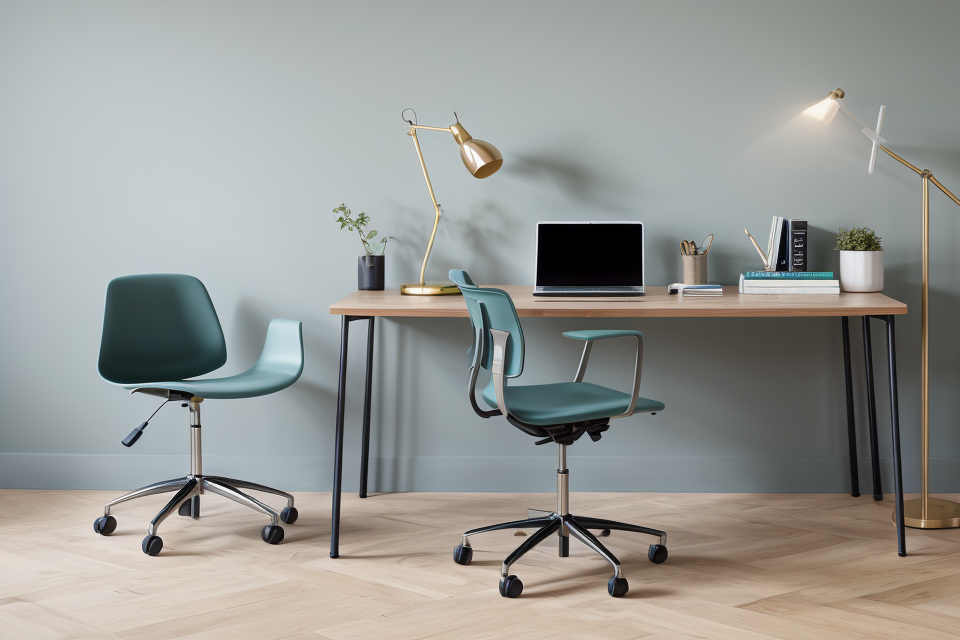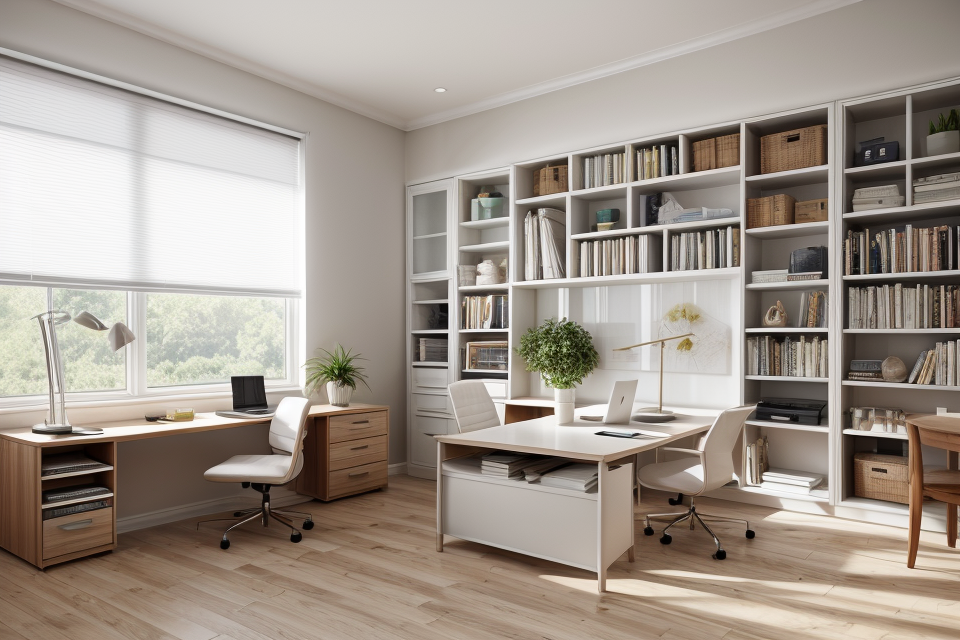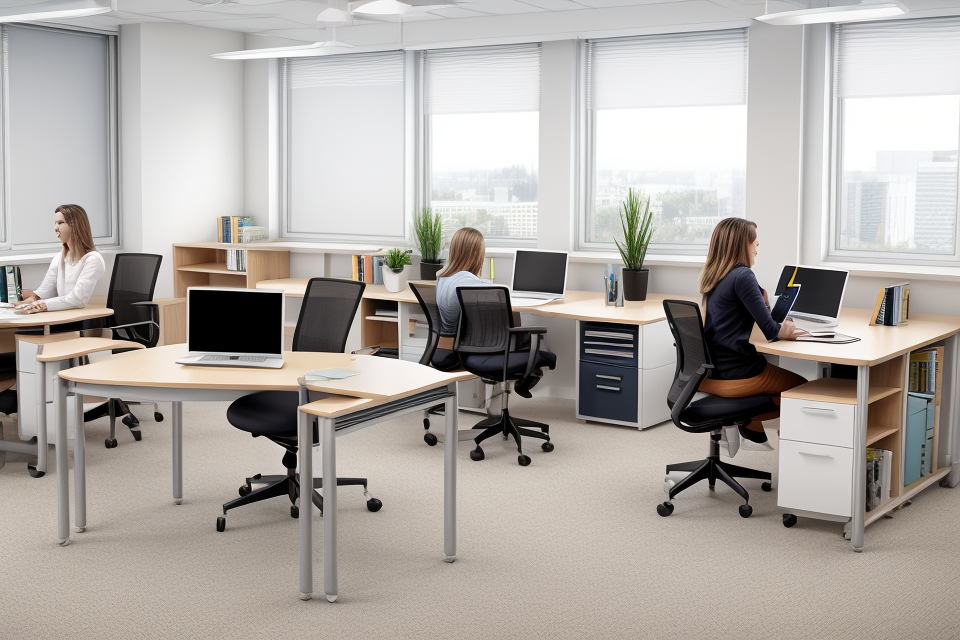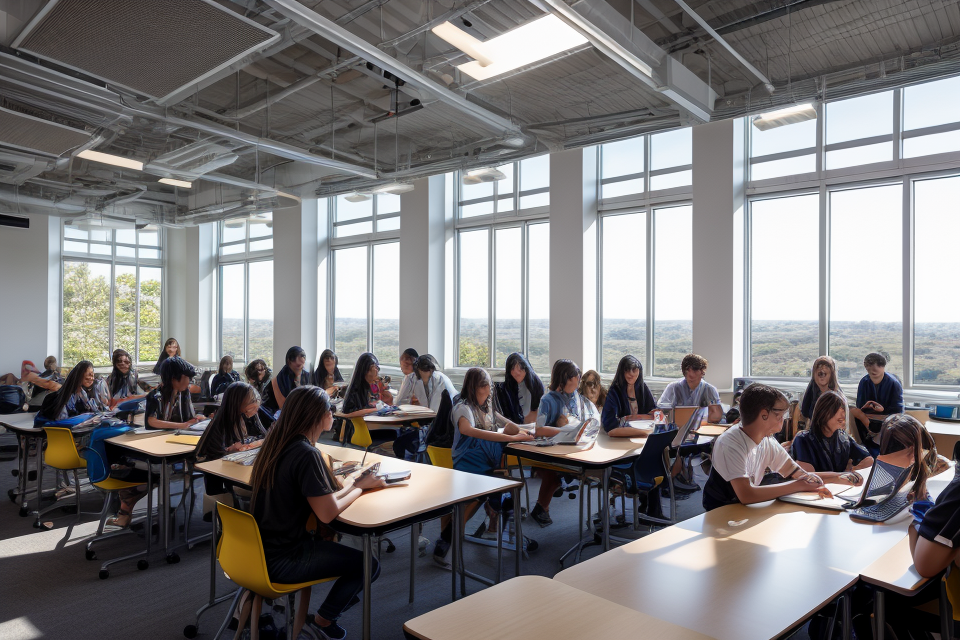
As students, we all strive to maximize our learning efficiency and achieve academic success. But have you ever wondered which study environment is the most effective for your learning style? Is it better to study in a quiet library, a bustling coffee shop, or in the comfort of your own home? In this article, we will explore the pros and cons of different study environments and provide you with insights on how to create the perfect study space that caters to your individual learning needs. So, let’s dive in and discover the secrets to maximizing your learning efficiency and achieving academic success!
Maximizing learning efficiency requires finding the best study environment. Factors such as noise level, lighting, temperature, and distractions should be considered. Ideally, a quiet and well-lit room with comfortable temperature and minimal distractions is optimal for studying. Some people may prefer studying in a library or a quiet coffee shop, while others may find a designated study area at home to be most effective. Experimenting with different environments and finding what works best for an individual’s learning style can help maximize efficiency. Ultimately, the goal is to create an environment that promotes focus and reduces distractions, allowing for more effective learning.
Factors Affecting Learning
Personal Characteristics
- Learning styles
An individual’s learning style refers to the manner in which they prefer to process and retain information. There are various learning styles, including visual, auditory, and kinesthetic. Visual learners prefer to learn through diagrams, images, and videos, while auditory learners benefit from lectures, discussions, and podcasts. Kinesthetic learners prefer hands-on activities and movement. Understanding one’s learning style can help in selecting the most effective study environment and strategies.
- Attention span
Attention span refers to the amount of time an individual can focus on a task before becoming distracted or losing interest. Some individuals have a shorter attention span, while others have a longer attention span. A shorter attention span may require breaking up study sessions into shorter intervals with breaks in between, while a longer attention span may allow for longer and more focused study sessions. It is important to recognize and accommodate one’s attention span to maximize learning efficiency.
- Memory capacity
Memory capacity refers to the ability to retain and recall information. Some individuals have a higher memory capacity than others, which may impact their ability to learn and retain information. Those with a higher memory capacity may benefit from more complex and detailed study materials, while those with a lower memory capacity may benefit from simpler and more repetitive study materials. It is important to understand one’s memory capacity and adjust study strategies accordingly to maximize learning efficiency.
Environmental Factors
When it comes to studying, the environment in which one chooses to study can greatly impact their learning efficiency. Here are some environmental factors that can affect one’s ability to learn:
- Lighting: The type of lighting in a study environment can have a significant impact on one’s ability to focus and retain information. Natural light has been shown to be the most beneficial for studying, as it can help improve mood and alertness. However, harsh or fluorescent lighting can be distracting and lead to eye strain.
- Temperature: The temperature of a study environment can also play a role in one’s ability to learn. Studies have shown that optimal temperature for studying is between 60-68 degrees Fahrenheit, as this temperature range is associated with increased alertness and focus.
- Noise level: The level of noise in a study environment can also impact one’s ability to learn. While some people may prefer complete silence, others may find that background noise helps them stay focused. However, excessive noise can be distracting and lead to decreased productivity.
- Comfort: Comfort is also an important factor in a study environment. Uncomfortable chairs, poor ventilation, or an uncomfortable temperature can all lead to decreased focus and productivity. Ensuring that one’s study environment is comfortable can help improve one’s ability to learn.
Understanding Individual Differences
Importance of Personalized Study Environments
One of the key factors in maximizing learning efficiency is recognizing the importance of personalized study environments. Each individual has unique needs and preferences when it comes to studying, and what works for one person may not work for another. By adapting to these individual needs, it is possible to create a study environment that is optimized for learning.
Here are some reasons why personalized study environments are important:
- Adapting to individual needs: Everyone has different learning styles, and what works for one person may not work for another. For example, some people may learn better in a quiet, isolated environment, while others may prefer a more stimulating and energetic environment. By adapting to individual needs, it is possible to create a study environment that is tailored to the individual’s learning style.
- Maximizing learning efficiency: By creating a personalized study environment, it is possible to maximize learning efficiency. This means that the individual is able to focus on the task at hand without distractions, and is able to absorb and retain information more effectively.
Overall, the importance of personalized study environments cannot be overstated. By recognizing and adapting to individual needs, it is possible to create a study environment that is optimized for learning and can help maximize learning efficiency.
Analyzing Different Study Environments
Home Environment
Pros
- Comfortable and familiar environment
- Ability to create a personalized study space
- Reduced distractions and interruptions
- Access to personal resources and materials
Cons
- Potential for distractions from home life
- Lack of supervision or guidance from teachers or peers
- Limited access to technology or specialized equipment
- Insufficient motivation or discipline to focus on studies
Library
The library is a popular choice among students as a study environment. It offers a quiet and focused atmosphere that is conducive to learning. However, there are both pros and cons to studying in a library.
- Quiet environment: The library is typically a quiet place, which makes it an ideal study environment for those who prefer a peaceful and serene atmosphere.
- Access to resources: Libraries are stocked with a wide range of books, journals, and other materials that can aid in learning and research.
- Focus on academics: A library environment is often associated with academic pursuits, which can help students stay focused on their studies.
-
No distractions: The library is free from the distractions of social media, television, and other electronic devices, which can be a significant hindrance to studying.
-
Limited seating: Libraries can be crowded, and finding a seat can be challenging, especially during peak hours.
- Time constraints: Some libraries have strict rules regarding noise levels and talking, which can be limiting for students who need to discuss concepts with their peers.
- Limited access to technology: While libraries offer access to computers and other technology, some students may prefer to use their own devices or need access to specialized software that is not available in the library.
- Distractions: While the lack of distractions can be beneficial, the presence of other students studying can be distracting for some students.
Overall, the library can be an excellent study environment for those who prefer a quiet and focused atmosphere and have access to the resources they need. However, it may not be the best option for everyone, and students should consider their individual needs and preferences when choosing a study environment.
Coffee Shops
- Pros
- Social Atmosphere: Coffee shops offer a lively and dynamic environment that can stimulate creativity and boost motivation.
- Access to Caffeine: The aroma of freshly brewed coffee and the availability of caffeinated beverages can enhance mental alertness and improve focus.
- Networking Opportunities: Frequenting coffee shops can provide opportunities to meet new people, engage in conversations, and build professional connections.
- Cons
- Distractions: The ambient noise, music, and chatter from other patrons can be distracting and hinder concentration.
- Limited Seating: Coffee shops often have limited seating options, which can be uncomfortable or unavailable during peak hours.
- Expensive: Over time, the cost of frequenting coffee shops can add up, making it an unaffordable study option for some individuals.
Outdoor Spaces
- Pros:
- Natural Light: Outdoor spaces provide ample natural light, which can be beneficial for enhancing concentration and alertness during study sessions.
- Fresh Air: Breathing in fresh air has been linked to improved cognitive function and memory retention, which can aid in the learning process.
- Physical Activity: Studying in an outdoor space may encourage short breaks for physical activity, such as taking a walk or engaging in some light exercise, which can enhance blood flow and improve focus.
- Minimal Distractions: Depending on the location, outdoor spaces can offer a serene environment with minimal distractions, allowing for better focus on study materials.
- Cons:
- Weather Dependent: The weather can significantly impact the effectiveness of studying in an outdoor space. Extreme temperatures, wind, or rain can be distracting and uncomfortable, negatively affecting the learning experience.
- Limited Resources: Outdoor spaces may not always have access to essential resources such as electricity, internet connectivity, or proper seating, which can hinder the learning process.
- Noise Levels: Depending on the location, outdoor spaces can be subject to noise pollution, which can negatively impact concentration and learning efficiency.
- Lack of Control: The environment in outdoor spaces can be unpredictable, which may cause stress and hinder the ability to control the learning environment effectively.
Strategies for Optimizing Study Environments
Minimizing Distractions
Minimizing distractions is crucial for an effective study environment. The following are some strategies that can help:
Creating a designated study area
Having a designated study area can help you focus on your studies and reduce distractions. The study area should be free from clutter and should have adequate lighting. Ideally, the study area should be separate from your living space to minimize interruptions. If possible, choose a quiet room without any background noise.
Setting aside specific times for study
Setting aside specific times for study can help you stay focused and avoid distractions. Choose a time when you are most alert and productive. You can also create a study schedule that includes breaks to avoid burnout. During the study periods, avoid multitasking and try to focus solely on your studies.
Limiting the use of electronic devices
Electronic devices such as smartphones and laptops can be major distractions during study sessions. To minimize distractions, it is best to limit the use of these devices during study periods. You can also consider turning off notifications or using apps that block distracting websites.
Managing social media usage
Social media can be a significant distraction during study sessions. It is essential to manage your social media usage to avoid distractions. You can set specific times to check your social media accounts or limit your usage to specific timeframes.
Eliminating noise
Noise can be a significant distraction during study sessions. If possible, choose a quiet study area, or use earplugs to block out noise. You can also consider using white noise or instrumental music to mask distracting noises.
By implementing these strategies, you can create an optimal study environment that minimizes distractions and helps you maximize your learning efficiency.
Maximizing Comfort
-
Ergonomic furniture
-
Proper lighting
-
Comfortable temperature
Ergonomic Furniture
Proper ergonomic furniture is crucial in ensuring a comfortable study environment. The right furniture can help prevent physical strain, reduce fatigue, and promote good posture, all of which contribute to increased learning efficiency. When selecting furniture, consider the following factors:
- Adjustable height: The desk or table should be adjustable in height to allow for comfortable viewing at different angles.
- Chair: A chair with adjustable height, backrest, and armrests will help maintain proper posture and reduce strain on the back and neck.
- Footrest: A footrest can help support the feet and reduce strain on the legs, which can improve overall comfort during long study sessions.
Proper Lighting
Proper lighting is essential for both physical and mental comfort during study sessions. Ideally, the study environment should have multiple light sources to provide optimal lighting conditions.
- Natural light: If possible, position the study area near a window to take advantage of natural light. Natural light is ideal for maintaining alertness and reducing eye strain.
- Artificial lighting: Use overhead lights or desk lamps to supplement natural light. Ensure that the light is not too harsh or glaring, as this can cause discomfort and eye strain.
- Adjustable lighting: If possible, choose lighting fixtures that can be adjusted to change the intensity and direction of the light. This will allow for better customization based on individual needs and preferences.
Comfortable Temperature
Maintaining a comfortable temperature in the study environment is essential for both physical and mental comfort. Extreme temperatures can lead to discomfort and distractions, which can negatively impact learning efficiency.
- Indoor temperature: The ideal indoor temperature for studying is generally considered to be between 18°C and 22°C (64°F and 72°F).
- Temperature regulation: Ensure that the study area is well-ventilated and that there is a reliable heating or cooling system to maintain a comfortable temperature.
- Dress appropriately: Dressing in layers or wearing appropriate clothing for the temperature can help maintain comfort during extended study sessions.
By focusing on maximizing comfort in the study environment, learners can create an optimal space for increased learning efficiency and reduced distractions. Ergonomic furniture, proper lighting, and a comfortable temperature are all critical factors to consider when creating an optimal study environment.
Leveraging Technology
One effective strategy for optimizing study environments is leveraging technology. With the advancements in technology, there are various tools and applications that can enhance the learning experience and improve efficiency. Here are some ways to leverage technology for an optimal study environment:
Utilizing noise-cancelling headphones
Noise-cancelling headphones are a great tool for blocking out distracting background noise, allowing for a more focused and productive study session. These headphones use advanced noise-cancellation technology to filter out ambient sounds, creating a quiet and conducive environment for learning.
Some benefits of using noise-cancelling headphones include:
- Improved concentration: By eliminating background noise, learners can maintain their focus on the learning material, leading to better retention and understanding.
- Enhanced comfort: Noise-cancelling headphones can provide a comfortable listening experience, reducing fatigue and discomfort during extended study sessions.
- Personalized noise reduction: Different headphones offer varying levels of noise reduction, allowing learners to customize their listening experience according to their specific needs.
Customizing study environment settings
Customizing the study environment settings can also contribute to a more efficient learning experience. With technology, learners can adjust various aspects of their environment, such as lighting, temperature, and noise levels, to create an ideal atmosphere for studying.
Some ways to customize the study environment include:
- Adjusting lighting: Bright and well-lit spaces can help increase alertness and focus during study sessions. However, harsh or glaring lighting can cause discomfort and strain on the eyes. Using technology, learners can dim or adjust the brightness of their lights to find the optimal level for their learning environment.
- Controlling temperature: The ideal temperature for studying can vary from person to person. Some individuals prefer a warmer environment, while others find it more comfortable to study in a cooler space. Technology allows learners to control the temperature of their study environment, creating a comfortable and conducive atmosphere for learning.
- Managing noise levels: As mentioned earlier, noise-cancelling headphones can be effective in blocking out distracting sounds. However, in some cases, learners may prefer to reduce noise levels in their environment without using headphones. Technology provides various noise-reduction tools, such as white noise machines or noise-masking apps, which can help create a more peaceful and focused study environment.
By leveraging technology in these ways, learners can optimize their study environments, leading to improved learning efficiency and outcomes.
Periodic Environment Changes
One strategy for optimizing a study environment is to incorporate periodic changes to the environment. This can involve changing the location or layout of the study area, as well as making adjustments to lighting, temperature, and other environmental factors.
- Preventing boredom
One of the benefits of incorporating periodic environment changes is that it can help prevent boredom. When studying in the same location or environment for an extended period, it can be easy to become complacent and lose focus. By changing up the environment, students can stay engaged and motivated. - Enhancing focus
Periodic environment changes can also help enhance focus. Studies have shown that changes in the environment can stimulate the brain and help improve concentration. For example, studying in a different room or location can help students break up their routine and stay focused on their work.
In addition to preventing boredom and enhancing focus, periodic environment changes can also help improve overall learning efficiency. By incorporating changes into their study routine, students can stay engaged and motivated, which can lead to better retention of information and improved performance on exams and assignments.
FAQs
1. What is the most effective study environment?
The most effective study environment is one that is quiet, comfortable, and free from distractions. This can be a designated study area at home or a library, where you can focus on your studies without interruption. Some people find that they are able to study more effectively in a quiet, peaceful environment, while others prefer a more lively atmosphere with background music or the sounds of nature.
2. Is it better to study in a quiet or noisy environment?
It depends on your personal preference and the type of study material you are working with. Some people find that they are able to study more effectively in a quiet, peaceful environment, while others prefer a more lively atmosphere with background music or the sounds of nature. If you are working with complex or challenging material, a quiet environment may be more helpful, as it allows you to focus and concentrate more easily. On the other hand, if you are working with material that is more straightforward or that you are already familiar with, a noisy environment may be less distracting and help you stay more focused.
3. Should I study in a group or alone?
It is generally best to study alone, as this allows you to focus more easily on your studies and concentrate more effectively. However, studying in a group can be helpful for reviewing material and discussing concepts with others. If you are struggling with a particular concept, discussing it with a group of peers can help you gain a deeper understanding of the material. Additionally, working in a group can help you stay motivated and on track with your studies.
4. What is the best time of day to study?
The best time to study is when you are most alert and focused. For some people, this is early in the morning, while for others it may be later in the day. Experiment with different times of day to see when you are most productive and able to concentrate most effectively. It is generally best to avoid studying when you are tired or when you are likely to be distracted by other activities or commitments.
5. How long should I study at a time?
It is generally best to study in shorter, more frequent sessions rather than longer, more infrequent sessions. This allows you to stay focused and concentrated, and it also helps you retain the material more effectively. It is generally recommended to study for 25-30 minutes at a time, taking a short break after each session to rest and recharge. This can help you maintain your energy and focus throughout the study session.


